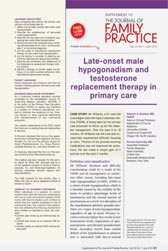User login
Hypogonadism is a highly prevalent condition that is under-diagnosed and under-treated despite available effective therapies. Low levels of testosterone result in losses of lean body mass and bone mass, decreases in libido and sexual function and is associated with insulin resistance, metabolic syndrome, diabetes, and other chronic comorbid conditions. It is important for physicians to be aware of how testosterone levels can be related to these conditions, which are seen in primary care practices on a daily basis.
This CME supplement discusses the definition, epidemiology and key signs and symptoms of late-onset hypogonadism, the role of lab measurements, factors to consider in selecting patients for testosterone replacement therapy, and how to identify the best treatment strategy for each patient.
Hypogonadism is a highly prevalent condition that is under-diagnosed and under-treated despite available effective therapies. Low levels of testosterone result in losses of lean body mass and bone mass, decreases in libido and sexual function and is associated with insulin resistance, metabolic syndrome, diabetes, and other chronic comorbid conditions. It is important for physicians to be aware of how testosterone levels can be related to these conditions, which are seen in primary care practices on a daily basis.
This CME supplement discusses the definition, epidemiology and key signs and symptoms of late-onset hypogonadism, the role of lab measurements, factors to consider in selecting patients for testosterone replacement therapy, and how to identify the best treatment strategy for each patient.
Hypogonadism is a highly prevalent condition that is under-diagnosed and under-treated despite available effective therapies. Low levels of testosterone result in losses of lean body mass and bone mass, decreases in libido and sexual function and is associated with insulin resistance, metabolic syndrome, diabetes, and other chronic comorbid conditions. It is important for physicians to be aware of how testosterone levels can be related to these conditions, which are seen in primary care practices on a daily basis.
This CME supplement discusses the definition, epidemiology and key signs and symptoms of late-onset hypogonadism, the role of lab measurements, factors to consider in selecting patients for testosterone replacement therapy, and how to identify the best treatment strategy for each patient.
